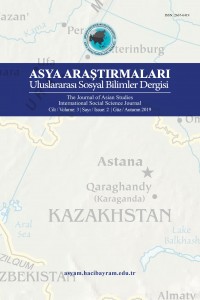Öz
İngiltere´nin
kolonilerinden birisi olan Bengal´de gerçekleşmiş 1770 ve 1943-1944
kıtlıklarında milyonlarca insan hayatını kaybetmiştir. 1770 kıtlığı
İngilizlerin yerel halka uyguladığı ağır vergiler ve ürün yetiştirme
politikasındaki değişikler nedeni ile yaşanmıştır. 1943-1944 kıtlığının
yaşanmasında ise 2. Dünya savaşı şartlarında İngilizlerin ülkede uyguladığı
yanlış politikalar etkilidir. Kendi çıkarlarını Bengal halkının önünde tutan
İngilizler halkı açıkça açlığa mahkûm etmiştir. Bu dönemde Bengal´in Japonlarca
istila edilebileceğini düşünen İngilizler ülkenin zengin tarım ürünlerinin
Japonların eline geçmemesi için gayret sarf etmişlerdir. Japonları aç bırakma
planları ile yerel halk açlığa mahkûm edilmiştir. Kıtlık baş gösterince de
elinde imkân olmasına rağmen İngilizler halka yeterli yardımı yapmamıştır.
Gerek 1770 gerekse 1943-1944 kıtlığında ülkeyi fiilen yöneten İngilizler olduğu
için kıtlıklar ile İngilizler arasındaki bağın araştırılması gereklidir.
Böylece Hint halkının İngiliz yönetimi altında nasıl hayat mücadelesi verdiğinin
daha iyi anlaşılacağı düşünülmektedir.
Anahtar Kelimeler
Kaynakça
- Aykroyd, W. R. (1974). The Conquest of Famine. London: Chatto & Windus.Arnold, D. (1988). Famine. Social Crisis And Historical Change. Oxford: Basil Blackwell. Beliappa, K. C. (1991). The Image of India in English Fiction. Delhi: B.R. Publishing Corporation. Bhatia, B. M. (1967). Famines in India: A Study in Some Aspects Of The Economic History of India (1860-1965). London: Asia Publishing House. 2nd Edition.Blackwell, F. (Fall 2008). The British Impact on India, 1700–1900. Education About Asia, Volume 13, Number 2, 34-37. Caldwell, J. C. (December 1998). Malthus and the Less Developed World: The Pivotal Role of India. Population and Development Review 24 (4), 675-696.Cannon, G. (May 2014). What do you think?. World Nutrition, Volume 5, Number 5, 472-485.Carey, H. C. (1853). The Slave Trade, Domestic and Foreign: Why It Exists, and How It May Be Extinguished. How Slavery Grows in India, Chapter XII.Chawla, A. (2005). The Great Holocaust of Bengal. 1-8. http://www.samarthbharat.com/bengalholocaust.htm adresinden erişildi. (ET: 19.02.2019)Connell, A. K. (1884). Indian Pauperism, Free Trade And Railways: A Paper Read Before the East India Association. Bristol: Selected Pamphlets.Davis, M. (2000). Late Victorian Holocausts: El Nino Famines and the Making of theThird World. London: Verso Books.Devereux, S. (1993). Theories of Famine. London: Harvester Wheatsheaf.Dutt, Romesh (1901). Indian Famines: Their Causes and Prevention. London: P. S. King and Son.Famine Inquiry Commission (1945a). Report on Bengal. New Delhi: Government of India Press.Fullarton, W. (1788). A View of the English Interests in India. London: Cadell.Ghosh, K. C. (1944). Famines in Bengal- 1170-1943. Calcutta: Indian Associated Publishing. Ed. Meena, H. K. (2016). Railway and Famines in British India. Greenough, P. R. (1982). Prosperity and Misery in Modern Bengal: The Famine of 1943-44. New York: Oxford University Press. Jarboe, A. T. (2013). Soldiers Of Empire Indian Sepoys in and Beyond The Imperial Metropole During The First World War, 1914-1919. Yayınlanmamış Doktora Tezi, The Department of History, Northeastern University, Boston, Massachusetts, USA.Hardiman, D. (1998). Well Irrigation in Gujarat: Systems of Use, Hierarchies of Control.Economic and Political Weekly, 20 June, 1533-1534.Klein, I. (1990). Population Growth and Mortality in British India. part II. The Demographic Revolution in Indian Economic and Social History Review, vol. 27, no.1: 33-64.Latham, A. (1978). The International Economy and the Undeveloped World, 1865–1914. London.Lewis, W.A. (1978). Growth and Fluctuations, 1870-1913. London.Maddison, A. (1971). The Economic and Social Impact of Colonial Rule in India. Chapter 3 of Class Structure and Economic Growth: India & Pakistan since the Moghuls. New York: W. W. Norton.Maharatna, A. (1992). The Demography Of Indian Famines: A Historical Perspective. Yayınlanmamış Doktora Tezi, London School Of Economics and Political Science, University of London, England.Maitra, R.(2015). British Colonials Starved to Death 60 million-plus Indians, But, Why?. EIR: Executive Intelligence Review, July 3, 20-25.McAlpin, M.B. (1983). Subject to famine: Food Crises and Economie Change in Western India, 1860-1920, Princeton: Princeton University Press. Mukherji, K. (1965). Agriculture, Famine and Rehabilitation in South Asia: A Regional Approach, Santiniketan: Visva Bharati University press. Nanda, S. P. (2003). Economic and Social History of Modern India. New Delhi: Anmol Publication Pvt. Ltd. in Meena, H. K. (2016). Railway and Famines in British India. Nightingale, F. ve Vallee, G. (2006). Florence Nightingale on Health in India. Waterloo (Ontario): Wilfrid Laurier University Press. Parliamentary Papers.(1881). 68. Famine Commission - Financial Statement. quoted in Watts, S. (1997). Epidemics and History, Disease, Power and Imperialism. New Haven: CT. Pomeranz, K. (2000). The Great Divergence: China, Europe and the Making of the Modern World Economy, New Jersey: Princeton.Rahman, A. (2012). "Famine". In Islam, Sirajul; Jamal, Ahmed A. Banglapedia: National Encyclopedia of Bangladesh (Second ed.). Asiatic Society of Bangladesh. Rothermund, D. (1988). An Economic History of India, New York. Roy, T. (2013). The Economic History of India 1857-1947. New Delhi: Oxford University Press. Third edition. in Meena, H. K. (2016). Railway and Famines in British India. Sarkar, S. (1972). Hindu-Muslim Relations in Swadeshi Bengal 1903-1908. Indian Economic and Social History Review, vol.9, no.2, 161-216.Satya, L.(1994). Cotton and Famine in Berar, 1850-1900.Yayınlanmamış Doktora Tezi, Tufts University.Sen, A. K. (1981). Poverty and Famines: An Essay on Entitlement and Deprivation, Oxford: Clarendon Press.Sharma, S. (1993). The 1837-38 Famine in U.P.: Some Dimensions of Popular Action. The Indian Economic and Social History Review, 30: 3, 359.Statesman Daily. (1943). Calcutta. The Death-Roll, 16.10.1943. editorial, Sept. 23.The Corner House, (2002). Briefing 27: The Origins of the Third World, December. 10.Vanhaute, E. (2009). From Famine To Food Crisis: What History Can Teach Us About Local And Global Subsistence Crises. Munich Personal Repec Archive, 6.Walford, C. (1878). The Famines of the World, London.Whitcombe, E. (1983). Irrigation in Kumar, D. (ed.) The Cambridge Economic History of India, Volume Two: 1757-c.1970, Cambridge, 678.Wong, J.W. (1998). Deadly Dreams: Opium and the Arrow War 1856-1860 in China. Cambridge: Cambridge Press.
Ayrıntılar
| Birincil Dil | İngilizce |
|---|---|
| Bölüm | Makaleler |
| Yazarlar | |
| Yayımlanma Tarihi | 30 Aralık 2019 |
| Yayımlandığı Sayı | Yıl 2019 Cilt: 3 Sayı: 2 |


